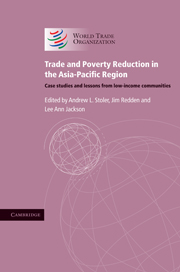 Trade and Poverty Reduction in the Asia-Pacific Region
Trade and Poverty Reduction in the Asia-Pacific Region Published online by Cambridge University Press: 05 March 2012
Introduction
Accounts differ, but it is probably right to say that there are between 63,000 and 77,000 transnational corporations (TNCs) driving today's global economy. TNCs’ presence and influence are felt everywhere from New York to Bangalore to Nairobi, by people in all walks of life, by wealthy shareholders and assembly-line workers earning the minimum wage. TNCs dominate world production, foreign direct investment (FDI) and international distribution networks. Their assets and revenues are sometimes compared (usually incorrectly) with small nations’ gross domestic product (GDP). Such comparisons are utterly misleading because those making them usually confuse the gross sales of the companies with countries’ GDP.
Transnationals are praised by those who maintain that they are efficient at creating new employment opportunities in developing countries and at serving as the link between local businesses and overseas markets that these businesses might not otherwise access, and that they are an important source of technology transfer to host countries. TNCs are also the principal targets of anti-globalisation critics. Some argue that TNCs are associated with environmental degradation, abuse of labour rights and exploitatively low wages, and that their activities are damaging to the prospects for sustainable growth in poorer regions of the world. We have all seen the sweatshop accusations by critics of TNCs. In China, TNCs have contributed to the huge FDI flows that have powered the economy at a white-hot rate of growth, but some economists argue that manufacturing in China is a modern example of immiserising growth.
To save this book to your Kindle, first ensure [email protected] is added to your Approved Personal Document E-mail List under your Personal Document Settings on the Manage Your Content and Devices page of your Amazon account. Then enter the ‘name’ part of your Kindle email address below. Find out more about saving to your Kindle.
Note you can select to save to either the @free.kindle.com or @kindle.com variations. ‘@free.kindle.com’ emails are free but can only be saved to your device when it is connected to wi-fi. ‘@kindle.com’ emails can be delivered even when you are not connected to wi-fi, but note that service fees apply.
Find out more about the Kindle Personal Document Service.
To save content items to your account, please confirm that you agree to abide by our usage policies. If this is the first time you use this feature, you will be asked to authorise Cambridge Core to connect with your account. Find out more about saving content to Dropbox.
To save content items to your account, please confirm that you agree to abide by our usage policies. If this is the first time you use this feature, you will be asked to authorise Cambridge Core to connect with your account. Find out more about saving content to Google Drive.